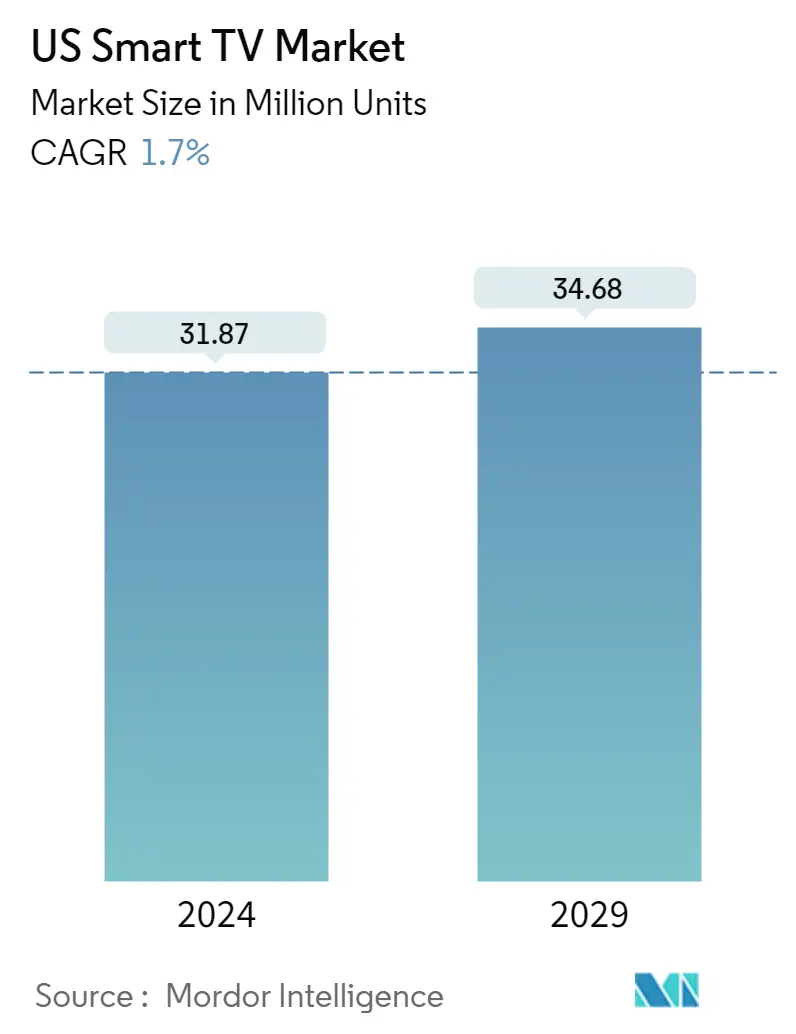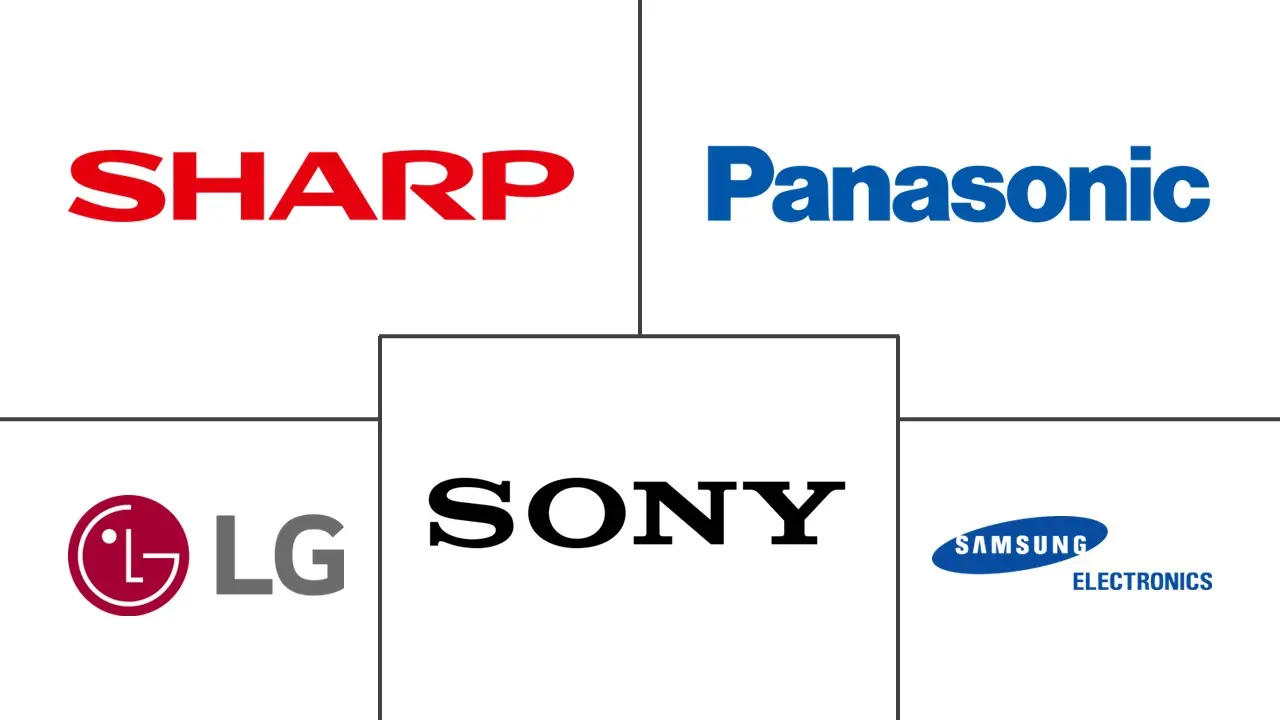Market Size of US Smart TV Industry

| Study Period | 2019 - 2029 |
| Base Year For Estimation | 2023 |
| Market Volume (2024) | 31.87 Million units |
| Market Volume (2029) | 34.68 Million units |
| CAGR (2024 - 2029) | 1.70 % |
| Market Concentration | Low |
Major Players
*Disclaimer: Major Players sorted in no particular order |
US Smart TV Market Analysis
The US Smart TV Market size is estimated at 31.87 Million units in 2024, and is expected to reach 34.68 Million units by 2029, growing at a CAGR of 1.7% during the forecast period (2024-2029).
The increasing adoption of OTT services leading to the preference of smart TVs as a typical streaming entertainment product and the Us-China trade dispute prompting smart TV vendors dependent on Chinese manufacturing to expand shipments for building safety stocks are the two major factors driving the growth of smart TV in the United States.
- Streaming media such as Apple TV, Amazon Fire TV, and Google Chromecast are changing the consumers' viewing experience. Several manufacturers are teaming up with OTT (over-the-top) content and device providers to provide built-in features with no further requirement of a set-top box. For instance, TCL Corporation has teamed up with Roku Inc. and introduced a 4K HDR Roku TV.
- Furthermore, viewership of online material has expanded dramatically in recent years as high-speed broadband access has increased. Furthermore, the expanding electronics sector has started merging different technical advancements, including voice command and computational intelligence, with growing demand for intelligent gadgets, including smart TVs.
- Additionally, the increasing product development by major market players is expected to contribute to segment growth over the study period. For instance, in March 2022 - LG Display first introduced a 77-inch 8K OLED TV panel with MLA technology at the Society for Information Display's (SID) Display Week 2022, which was held in San Jose, California, on the 10th (local time) for three days. LG Display's 77-inch 8K OLED TV was the first in the world to use EX technology and MLA.
- Further, an ever-expanding universe of video streaming services, each with its exclusive TV shows and movies, is attracting a growing audience. According to the Consumer Technology Association, spending on video streaming services reached USD 47 billion in 2022, a 7% increase over 2021.
- For instance, 2021 saw 8K TV makers get into gear. Alongside the usual trio of 8K resolution screens from Samsung 8K TV, such as QN900A, QN800A, and QN700A, LG also brought several 8K-capable models that feature their Mini LED technology. Other brands are also launching, such as TCL's 6-Series 8K QLED, proving the cheapest 8K TV in the United States.
- Moreover, the increasing penetration of ultra-high-speed internet and highly efficient network infrastructure are expected to favorably impact the Smart TV Resolutions. For instance, the US federal government plans to build a centralized 5G wireless network nationwide by 2021. Recently, the White House released its National Strategy to Secure 5G in the US, mainly focusing on upgrading and securing 5G infrastructure at home and abroad.
- The COVID-19 pandemic has drastically impacted the lifestyles and routines of all consumers. Shelter-in-place orders and work-at-home mandates have driven in-home video consumption to unprecedented levels. The growing number of smartphone users in emerging economies has acted as a significant catalyst for smart TV as users look to continue their streaming content consumption on more giant screens when at home.
US Smart TV Industry Segmentation
A smart TV is a type of television that offers numerous features when connected to the internet. These include on-demand content from various apps, access to streaming services like Netflix, and the capability to communicate with other wireless devices, such as smartphones and tablets. The studied market is segmented by screen size (diagonal), such as 30-45 inches, 45-55 inches, 55 inches, and above by various resolution types, such as 4K UHD TV, Full HD TV, HDTV, different panel types such as LCD, LED, OLED, QLED with the reasonable pricing ranges such as under USD 1,000, USD 1,000 to, USD 2,000, USD 2,000 to USD 3,000, USD 3,000 and above which available in multiple operating segments such as Android, Tizen, WebOS, and Roku. The market sizes and forecasts are provided in terms of value (USD million) for all the above segments.
| By Screen Size (Diagonal) | |
| 30-45 Inches | |
| 45-55 Inches | |
| 55 Inches and above |
| By Resolution Type | |
| 4K UHD TV | |
| Full HD TV | |
| HDTV |
| By Panel Type | |
| LCD | |
| LED | |
| OLED | |
| QLED |
| By Pricing Range | |
| Under USD 1,000 | |
| USD 1,000 to USD 2,000 | |
| USD 2,000 to USD 3,000 | |
| USD 3,000 and Above |
| By Operating Segment | |
| Android | |
| Tizen | |
| WebOS | |
| Roku | |
| Other Operating Systems |
US Smart TV Market Size Summary
The US smart TV market is experiencing a steady expansion, driven by the increasing adoption of over-the-top (OTT) services and the strategic shifts in manufacturing due to geopolitical factors. The preference for smart TVs as primary devices for streaming entertainment is growing, supported by partnerships between manufacturers and OTT providers to integrate built-in features, eliminating the need for separate set-top boxes. The market is also witnessing a surge in demand for larger screens, as consumers seek immersive audio-visual experiences, a trend accelerated by the COVID-19 pandemic. The shift towards bigger screens is further fueled by rising per capita income and a growing inclination towards premium and luxurious home entertainment products. The integration of advanced technologies such as voice command and computational intelligence in smart TVs is enhancing consumer engagement, while the expansion of high-speed internet infrastructure is facilitating better smart TV resolutions.
The competitive landscape of the US smart TV market is marked by significant investments from major players in innovative technologies like OLED and QLED displays, which are becoming increasingly popular. The introduction of large-screen models and the adoption of quantum dot technology are expected to drive market growth. Price reductions in OLED TVs and the emergence of new industry participants are likely to make these advanced displays more accessible, further boosting demand. The market is also seeing collaborations and product launches aimed at enhancing the home entertainment experience, with companies like LG, Samsung, and Panasonic leading the charge. As the market continues to evolve, the focus on integrating smart features and improving display technologies is expected to sustain the growth trajectory of smart TVs in the United States.
US Smart TV Market Size - Table of Contents
-
1. MARKET INSIGHTS
-
1.1 Market Overview
-
1.2 Industry Attractiveness - Porters Five Forces Analysis
-
1.2.1 Bargaining Power of Suppliers
-
1.2.2 Bargaining Power of Buyers
-
1.2.3 Threat of New Entrants
-
1.2.4 Threat of Substitutes
-
1.2.5 Intensity of Competitive Rivalry
-
-
1.3 Industry Value Chain Analysis
-
1.4 Assessment of Impact of COVID-19 on the Market
-
-
2. MARKET SEGMENTATION
-
2.1 By Screen Size (Diagonal)
-
2.1.1 30-45 Inches
-
2.1.2 45-55 Inches
-
2.1.3 55 Inches and above
-
-
2.2 By Resolution Type
-
2.2.1 4K UHD TV
-
2.2.2 Full HD TV
-
2.2.3 HDTV
-
-
2.3 By Panel Type
-
2.3.1 LCD
-
2.3.2 LED
-
2.3.3 OLED
-
2.3.4 QLED
-
-
2.4 By Pricing Range
-
2.4.1 Under USD 1,000
-
2.4.2 USD 1,000 to USD 2,000
-
2.4.3 USD 2,000 to USD 3,000
-
2.4.4 USD 3,000 and Above
-
-
2.5 By Operating Segment
-
2.5.1 Android
-
2.5.2 Tizen
-
2.5.3 WebOS
-
2.5.4 Roku
-
2.5.5 Other Operating Systems
-
-
US Smart TV Market Size FAQs
How big is the US Smart TV Market?
The US Smart TV Market size is expected to reach 31.87 million units in 2024 and grow at a CAGR of 1.7% to reach 34.68 million units by 2029.
What is the current US Smart TV Market size?
In 2024, the US Smart TV Market size is expected to reach 31.87 million units.

